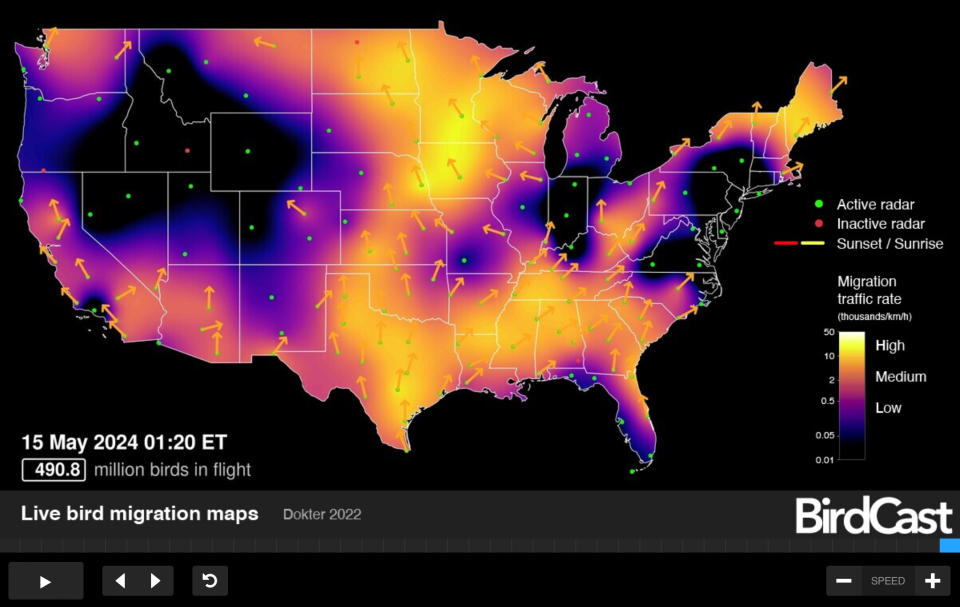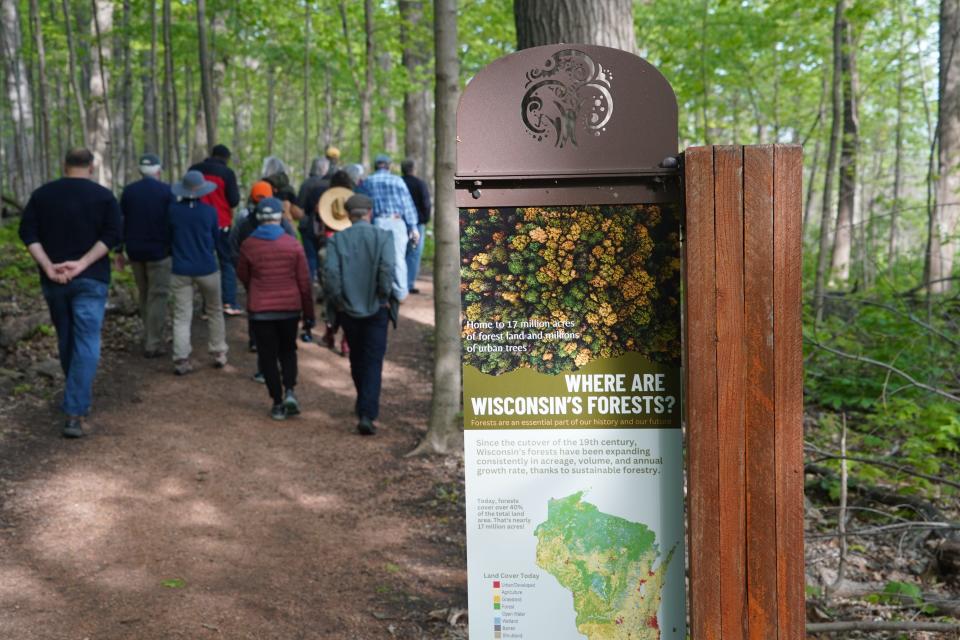With spring migration peaking in the Milwaukee area, here are seven top birding spots
Bird migration is synonymous with spring in Wisconsin.
It starts with early migrators including waterfowl and continues with species such as red-winged blackbirds that travel perhaps a few hundred miles.
It climaxes in May with with the arrival of the neotropical migrants, birds such as Baltimore orioles, great-crested flycatchers and bay-breasted warblers that have traveled from Central and South America to their northern breeding grounds.
"Right now is prime time for bird viewing in Milwaukee and really all of Wisconsin," Carl Schwartz of Fox Point, past president of the Wisconsin Society for Ornithology, said on Sunday as he led a bird hike in Wauwatosa. "With the influx of migrants, the variety of species and the number of birds is as good as it gets."
Modern technology is in agreement with Schwartz's decades of experience. May 15 is the annual peak of spring migration in Milwaukee, according to BirdCast, a radar-based forecast of bird movements run by the Cornell University Lab of Ornithology, Colorado State University and University of Massachusetts Amherst.
The BirdCast network estimated 490.8 million birds were in flight early Wednesday morning, among the largest flights this spring.

And when it comes to areas to see birds during spring migration, the shoreline of Lake Michigan is among the best in the country.
As the birds use south and southwest winds to assist their spring migratory flights, they set down or travel along the Wisconsin shore rather than get pushed over the expanse of the inland sea.
This creates an unusually high concentration of birds in lakeshore habitat, including in Milwaukee.
"The areas within a couple miles of the lake are typically loaded with many more migrants than you find in most other places in the Midwest," said Tom Prestby of Green Bay, Audubon Great Lakes conservation manager.
Prestby and Schwartz encouraged birders of all experience levels, and perhaps especially those new to the hobby, to get out in the coming days to look for birds.
Remember to observe from a respectable distance through binoculars and don't stress the birds by causing them to flush or otherwise change their behavior.
Here are seven top sites in and around Milwaukee for bird viewing during spring migration.

Lake Park in Milwaukee
Lake Park in Milwaukee was designed by landscape architect Frederick Law Olmsted and is listed on the National Register of Historic Places but its woods and fields also provide critical stopover habitat for migrating birds. The 137-acre property is part of the Milwaukee County Parks system. The Lake Park Friends group organizes a free, informal "Warbler Walk" from 8:30 to 10:30 a.m. on Saturdays in May. The park is located at 3233 E. Kenwood Blvd., Milwaukee.
Warnimont Park
Warnimont Park, also part of Milwaukee County Parks, spans 248 acres of bluffs, woods and fields on the Lake Michigan shore in Cudahy. It also includes Warnimont Bluff Fens, a State Natural Area. The green space is a magnet for spring migrants. It is located at 5400 S. Lake Drive, Cudahy.
Forest Exploration Center
Forest Exploration Center is a 67-acre, mature hardwood forest in Wauwatosa owned and managed by the Wisconsin Department of Natural Resources. The property has a mix of large trees, including maple, oak and basswood, that offer nesting and stopover habitat for a documented 158 species of birds. A trail system winds through the woods and allows easy access. It is located at 1800 Forest Exploration Drive, Wauwatosa.
Schlitz Audubon Nature Center
Schlitz Audubon Nature Center was cleared for farming many years ago, including to house Schlitz Brewery draft horses, but over the last 40 years the 185-acre site on Lake Michigan in northern Milwaukee County has been transformed into prairies, wetlands and woodlands. It features six miles of trails and access to the Lake Michigan beach. It is located at 1111 E. Brown Deer Road. Milwaukee.
Wehr Nature Center
Wehr Nature Center is a 220-acre nature preserve in Whitnall Park in Franklin. It was named for philanthropist Todd Wehr whose foundation donated funds to help build the center. The nature center features 6.5 miles of hiking trails through woods and prairies as well as a 20-acre lake. The Wehr Birders group meets for a bird hike from 8 to 10 a.m. Sundays. The nature center is located at 9701 W. College Ave., Franklin.
Vernon Wildlife Area
Vernon Wildlife Area is a 5,967-acre, state-owned tract in Waukesha County managed by the Wisconsin Department of Natural Resources. The Fox River runs through the property; it includes grasslands, oak savanna, lowland forest and wetlands. A 5.1-mile trail including boardwalks over marshy areas is being constructed and is scheduled to be completed by August, according to the DNR. Vernon Wildlife Area is located at S67W28435 River Road, Mukwonago.
Lion's Den Gorge Nature Preserve
Lion's Den Gorge Nature Preserve is a 73-acre public park along the Lake Michigan shore in Ozaukee County. It features grassland, wet meadow, woodland, wetland and bluff habitats as well as a network of trails. Similar to the other lakefront green spaces, Lion's Den provides critical stopover habitat for spring migrants. On May 4 a varied bunting was sighted at the park, the first record of the species in state history. The park is located at 511 High Bluff Drive, Grafton.
This article originally appeared on Milwaukee Journal Sentinel: Seven top birding spots in Milwaukee area for spring migration

